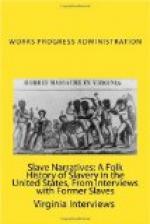Some of the citizens of Middlesboro today can recall stories that their parents told them about the days when slaves were bought and sold in the United States. Among these is one Mrs. Martha Neikirk, a daughter of an old Union soldier now deceased. Mrs. Rhuben Gilbert, Mrs. Neikirk’s mother said that: “Once my mother and I were out in the woods picking huckle-berries and heard a noise as of someone moaning in pain. We kept going toward the sound and finally came to a little brook. Near the water was a negro woman with her head bent over to the ground and weeping as if her heart was broken. Upon asking her what had caused her agony she finally managed to control her emotions enough to sob out her story. The negro woman said then that her master had just sold her to a man that was to take her far away from her present owner and incidently her children. She said this couldn’t be helped but she could ask the good Lord to let her die and get out of the misery she was in.
It seems that such incidents were common in those days. Mrs. Sarah Sloan, now residing in Middlesboro tells the stories her mother has told her and she remembers one story in particular about old Aunt Suzy, an old negro slave who, after the close of the Civil War lived near Mrs. Sloan’s mother. Aunt Suzy was the property of the Southern plantation owner and had lived on this plantation until she had raised a large family. One day a northern buyer came there and said he wanted to buy some slaves as cheap as possible so, aunt Suzy was getting old and not able to work as she once had, her owner naturally thought that while he had the chance he should sell her but he wanted to keep her children as they were young and able to do hard work. So poor old Aunt Suzy was sold along with some others and taken North. Here she was bought by another trader and sold to a new master. It seems this new master was kind to her and felt sympathy for her in her distress. She told him how she had lived on the old plantation so long and how she had never thought that when she became old and lonely that she would forever be separated from her children so the new [TR: owner?] said he would see what he could do, if anything. He made a trip to her former home and had a talk with the owner of the plantation. The plantation owner said that he had a bad crop year and heavy losses and much as he needed all the help possible to put in more crops he could not afford to buy more slaves, much less one that was unable to work. At this, Aunt Suzy’s new owner being a generous, kind-hearted man, decided to give the old lady back to him. He knew he could not get much money for her if he did sell her, for no one wanted an old slave that was unable to work. Aunt Suzy after all her traveling got to return to her old plantation and when the slaves were freed she lived with one of her children until her death.




